1,3-Dichloropropene
| |||
| |||
| Names | |||
|---|---|---|---|
| Preferred IUPAC name
1,3-Dichloroprop-1-ene | |||
| Other names
AQL Agrocelhone, DD92, 1,3-D, Dorlone, Nematox, Telone,[1][2] Nemex, cis-Dichloropropene, Di-Trapex CP, Vorlex 201, dichloro-1,3-propene, 1,3-dichloro-1-propene, 1,3-dichloro-2-propene, alpha-chloroallylchloride, chloroallylchloride, gamma-chloroallylchloride, chloroallyl chloride, chloroorpropenyl chloride, 1,3-dichloropropylene, 3-D, DCP, 3-Chloroallyl chloride | |||
| Identifiers | |||
3D model (JSmol) |
|||
| ChEBI | |||
| ChEMBL | |||
| ChemSpider | |||
| ECHA InfoCard | 100.008.024 | ||
| EC Number |
| ||
| KEGG | |||
| MeSH | 1,3-dichloro-1-propene | ||
PubChem CID |
|||
| RTECS number |
| ||
| UNII | |||
| UN number | 2047 | ||
CompTox Dashboard (EPA) |
|||
| |||
| |||
| Properties | |||
| C3H4Cl2 | |||
| Molar mass | 110.97 g/mol | ||
| Appearance | Colorless to straw-colored liquid | ||
| Odor | sweet, chloroform-like | ||
| Density | 1.217 g/mL (cis); 1.224 g/mL (trans) | ||
| Melting point | −84.5 °C (−120.1 °F; 188.7 K) | ||
| Boiling point | 104 °C (219 °F; 377 K) (cis); 112 °C (trans) | ||
| 2.18 g/L (cis) @ 25 °C; 2.32 g/L (trans) @ 25 °C | |||
| log P | 1.82 | ||
| Vapor pressure | 34.4 mm Hg @ 25 °C (cis); 23.0 mm Hg @ 25 °C (trans) | ||
| Hazards | |||
| GHS labelling: | |||
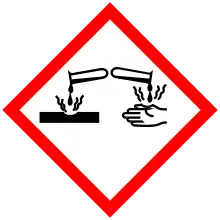 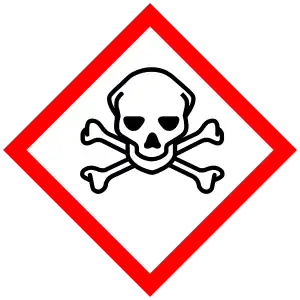 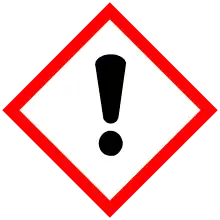 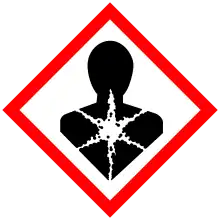 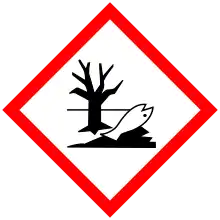 | |||
| Danger | |||
| H226, H301, H302, H305, H311, H315, H317, H319, H331, H332, H335, H410 | |||
| P210, P233, P240, P241, P242, P243, P261, P264, P270, P271, P272, P273, P280, P301+P310, P302+P352, P303+P361+P353, P304+P312, P304+P340, P305+P351+P338, P311, P312, P321, P322, P330, P331, P332+P313, P333+P313, P337+P313, P361, P362, P363, P370+P378, P391, P403+P233, P403+P235, P405, P501 | |||
| NFPA 704 (fire diamond) | |||
| Flash point | 28 °C (82 °F; 301 K) | ||
| > 500 °C (932 °F; 773 K) | |||
| Explosive limits | 5.3% - 14.5% (80 °C) | ||
| NIOSH (US health exposure limits): | |||
PEL (Permissible) |
none[3] | ||
REL (Recommended) |
Ca TWA 1 ppm (5 mg/m3) [skin][3] | ||
IDLH (Immediate danger) |
Ca [N.D.][3] | ||
Except where otherwise noted, data are given for materials in their standard state (at 25 °C [77 °F], 100 kPa).
Infobox references | |||
1,3-Dichloropropene, sold under diverse trade names, is an organochlorine compound. It is colorless liquid with a sweet smell. It dissolves in water and evaporates easily. It is used mainly in farming as a pesticide, specifically as a preplant fumigant and nematicide. It is widely used in the US and other countries, but is in the process of being phased out in the European Union.[4]
Production, chemical properties, biodegradation
It is a byproduct in the chlorination of propene to make allyl chloride.[5]
It is usually obtained as a mixture of the geometric isomers, called Z-1,3-dichloropropene, and E-1,3-dichloropropene. Although it was first applied in agriculture in the 1950s, at least two biodegradation pathways have evolved. One pathway degrades the chlorocarbon to acetaldehyde via chloroacrylic acid.[6]
Safety
The TLV-TWA for 1,3-dichloropropene (DCP) is 1 ppm.[7] It is a contact irritant. A wide range of complications have been reported.[8]
Carcinogenicity
Evidence for the carcinogenicity of 1,3-dichloropropene in humans is inadequate, but results from several cancer bioassays provide adequate evidence of carcinogenicity in animals. In the US, the Department of Health and Human Services (DHHS) has determined that 1,3-dichloropropene may reasonably be anticipated to be a carcinogen. The International Agency for Research on Cancer (IARC) has determined that 1,3-dichloropropene is possibly carcinogenic to humans. The EPA has classified 1,3-dichloropropene as a probable human carcinogen.[8]
Use
1,3-Dichloropropene is used as a pesticide in the following crops:[9]
| Crop | Pounds (lb) | Primary Pesticide? |
|---|---|---|
| Tobacco | 12,114,887 | Yes |
| Potatoes | 12,044,736 | Yes |
| Sugar Beets | 5,799,613 | Yes |
| Cotton | 3,735,543 | Yes |
| Peanuts | 3,463,003 | Yes |
| Sweet Potatoes | 1,210,872 | Yes |
| Onions | 674,183 | Yes |
| Carrots | 531,752 | Yes |
| Watermelons | 133,801 | No |
| Cantaloups | 121,395 | No |
| Cucumbers | 76,735 | No |
| Strawberries | 71,753 | No |
| Sweet Peppers | 28,247 | No |
| Melons | 12,471 | No |
| Blueberries | 3,090 | No |
| Asparagus | 1,105 | No |
Contamination
The ATSDR has extensive contamination information available.[10]
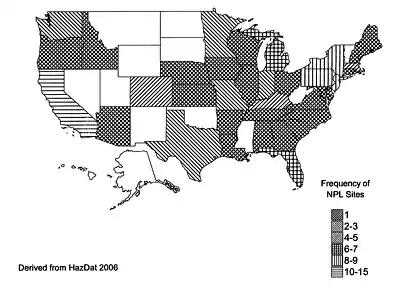
Market history
Under the brand name Telone, 1,3-D was one of Dow AgroSciences's products until the merger into DowDuPont. Then it was spun off with Corteva, and as of 2020 has been licensed to Telos Ag Solutions and is no longer a Corteva product.[1][2]
References
- Martin, Frank N. (2003). "Development of Alternative Strategies for Management of Soilborne Pathogens Currently Controlled with Methyl Bromide". Annual Review of Phytopathology. Annual Reviews. 41 (1): 325–350. doi:10.1146/annurev.phyto.41.052002.095514. ISSN 0066-4286. PMID 14527332.
- "Telone soil fumigant to be distributed by Telos Ag Solutions". Vegetable Growers News. 17 November 2020. Retrieved 6 July 2021.
- NIOSH Pocket Guide to Chemical Hazards. "#0199". National Institute for Occupational Safety and Health (NIOSH).
- COMMISSION DECISION of 20 September 2007 concerning the non-inclusion of 1,3-dichloropropene in Annex I to Council Directive 91/414/EEC and the withdrawal of authorisations for plant protection products containing that substance; is no longer in force, Official Journal of the European Union, 25 September 2007.
- Krähling, Ludger; Krey, Jürgen; Jakobson, Gerald; Grolig, Johann; Miksche, Leopold (15 June 2000), "Allyl Compounds", Ullmann's Encyclopedia of Industrial Chemistry, Weinheim, Germany: Wiley-VCH Verlag GmbH & Co. KGaA, doi:10.1002/14356007.a01_425, retrieved 18 March 2022
- Poelarends, Gerrit J.; Whitman, Christian P. (1 October 2004). "Evolution of enzymatic activity in the tautomerase superfamily: mechanistic and structural studies of the 1,3-dichloropropene catabolic enzymes". Bioorganic Chemistry. Mechanistic Enzymology. 32 (5): 376–392. doi:10.1016/j.bioorg.2004.05.006. ISSN 0045-2068.
- Robert L. Metcalf "Insect Control" in Ullmann’s Encyclopedia of Industrial Chemistry" Wiley-VCH, Wienheim, 2002. doi:10.1002/14356007.a14_263
- "ToxFAQs™ - Letter A | Toxic Substance Portal | ATSDR".
- "National Totals of Pesticide Use (pounds applied and acres treated) by Crop and Compound". USGS. Archived from the original on 10 April 2007.
- "TOXICOLOGICAL PROFILE FOR DICHLOROPROPENES" (PDF). Agency for Toxic Substances and Disease Registry. September 2008.



